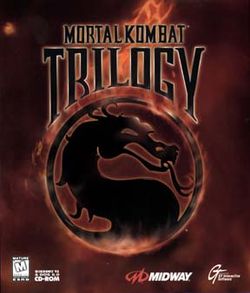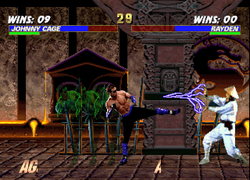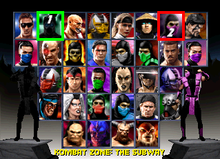- Mortal Kombat Trilogy
-
Mortal Kombat Trilogy 
North American PC box artDeveloper(s) Avalanche Software (PlayStation)
Williams Entertainment (N64)
Point of View, Inc. (Saturn, PC)Publisher(s) Williams Entertainment
(1996 releases)
Midway Home
(1997 and onwards releases)
GT Interactive
(PC and European releases)
SoftBank (Japanese release)Designer(s) Ed Boon and John Tobias Composer(s) Dan Forden Series Mortal Kombat Engine Updated Ultimate Mortal Kombat 3 engine Platform(s) PlayStation, Nintendo 64, Sega Saturn, PC, Game.com, R-Zone Release date(s) PlayStation
- NA September 1, 1996
- PAL December 6, 1996
- JP April 2, 1998
- NA October 31, 1996
- PAL March 14, 1997
- NA August 8, 1997
- PAL 1998
- NA August 31, 1997
- EU 1997
- NA January 1, 1998
Genre(s) Fighting game Mode(s) Up to 2 players simultaneously (8 on N64) Rating(s) BBFC: 15
ESRB: M (Mature) (Realistic Violence, Realistic Blood and Gore)
OFLC: MA
CERO: DMedia/distribution CD-ROM, ROM cartridge Mortal Kombat Trilogy is a fighting game developed and published by Midway in 1996. It is a compilation of content from the previous Mortal Kombat titles, based primarily upon the gameplay mechanics of Ultimate Mortal Kombat 3. Trilogy follows the same story as UMK3, but contains all characters and most of the stages from Mortal Kombat and Mortal Kombat II as well.
Contents
Cast and characters
Along with the UMK3 roster, MKT adds Baraka, and Raiden as they appeared in MKII. In addition to both characters gaining one new special move each, both characters have brand new sprites for running and standing falls (these animation types weren't introduced until ''Mortal Kombat 3). A new version of Johnny Cage played by a new actor was also introduced as well. He retains all of his regular moves from MKII except for the Split Punch, which had to be excluded since none of the characters from MK3/UMK3 had "reaction" sprites for this particular move. Bosses Goro, Kintaro, Motaro and Shao Kahn, are also now playable.
The PlayStation (PSX), Sega Saturn, and PC versions also contain alternate versions of Jax, Kung Lao, Kano and Raiden as they appeared in the first or second game, as they were the only actors who returned as special characters in the game; Ho Sung Pak (Liu Kang), Philip Ahn (Shang Tsung), Elizabeth Malecki (Sonya Blade), Katalin Zamiar (Kitana/Mileena/Jade) and Dan Pesina (Johnny Cage and Scorpion/Sub-Zero/Reptile/Smoke) left Midway prior to the production of MK3 due to royalty disputes. Johnny Cage is the only character to have all new sprites for this game; his new sprites are that of Chris Alexander. Pesina is the actor for the sprites used during Raiden's gameplay, but Sal Divita is used for the versus screen picture. In addition, new sprites were created to show MKII Raiden and Baraka running and falling from a standing position. New frames were also created for the original Kano to replace the old frames used for his victory stance and heart rip Fatality by modifying Kano's MK3 sprites.
A new secret character appears, as well. This character, known as Chameleon, rapidly switches between all the male ninjas (Classic Sub-Zero, Scorpion, Noob Saibot, Human Smoke, Rain, Reptile, and Ermac) during combat. He is similar to the original Mortal Kombat version of Reptile, but Chameleon changes his color, not just his stance. This character is playable by performing a special button combination.
Gameplay
 A combination of all previous games: Raiden is from the original Mortal Kombat, the Armory stage is from Mortal Kombat II, and the lifebar/other screen items (and general gameplay mechanics) are from Mortal Kombat 3/Ultimate Mortal Kombat 3, plus MKT-exclusive content such as the new Johnny Cage sprites and the aggressor bar.
A combination of all previous games: Raiden is from the original Mortal Kombat, the Armory stage is from Mortal Kombat II, and the lifebar/other screen items (and general gameplay mechanics) are from Mortal Kombat 3/Ultimate Mortal Kombat 3, plus MKT-exclusive content such as the new Johnny Cage sprites and the aggressor bar.
Mortal Kombat Trilogy introduces the Aggressor bar, which fills as the combatants fight (twice as much if the opponent is blocking). When the bar fills, the character becomes much faster and stronger for a short period of time.
A finishing move known as a Brutality is featured in this game: it requires the player to perform an 11-button combo which causes their opponent to explode. (Brutalities were also added to the Mega Drive/Genesis and SNES ports of UMK3.) All of the arenas that featured a Stage Fatality are featured in this game with their respective Fatalities except The Pit II. This arena's Stage Fatality had to be omitted as no MK3 characters had the unique sprites for falling off the bridge.
Many of the characters have brand new special moves and finishing moves. Several have unused special moves never implemented in previous games which made their first official appearance in Mortal Kombat Trilogy. These special moves include MK1 Kano's Spinning Blade move, MKII Kung Lao's Air Torpedo, Goro's Spinning Punch move, Raiden's Lightning that shoots from behind the opponent, and Baraka's Blade Spin move. In addition, Shao Kahn has a throw move and a grab and punch move that is exclusive to this game, and Motaro has added an overhead toss to his arsenal.
Almost every battle arena that has been featured in MKII, MK3, and UMK3 makes an appearance in MKT, however only a handful of backgrounds from the first Mortal Kombat make it into this game (Courtyard, Goro's Lair, The Pit, and The Pit Bottom). The PC, PSX, and Saturn versions only lack The Hidden Portal and Noob Saibot's Dorfen from MK3, while the Nintendo 64 version lacks Kahn's Arena and The Bank from MK2 and MK3, respectively. In some of the Kombat Zones a character can be uppercutted into different backgrounds: The Subway → The Street, The Bank → The Rooftop (only in the PC, PS and Saturn versions), The Soul Chamber → The Balcony, Scorpion's Lair → Kahn's Kave, Goro's Lair → The Armory → Kombat Tomb (N64 exclusive).
Audio
Most of the background music tracks remain intact from MKII and MK3, especially for the CD-ROM versions of the game. In all versions of the game, many of the songs do not match their respective arenas when compared to their original arcade counterparts. In all versions of MKT, none of the music appears from the original Mortal Kombat game. All of the CD-ROM games read the background music directly from the CD disk providing high-quality CD sound. Unfortunately, they lack all song endings as well as all of the music loops used when "Finish Him/Her" appears during a matches finale. All of the music taken from MK3 on the CD-ROM MKT games is noticeably slowed down in both speed and pitch. When these particular songs were converted to MKT's Red Book CD quality, they were downsampled from 48 kHz to 44.1 kHz without resampling them to maintain the original tempo and pitch in the PC, PSX and Saturn versions.
Versions
PlayStation
There were at least three public revisions of this game for the PlayStation (the final version was the North American Greatest Hits and European Platinum edition). With each revision, aspects of the gameplay were refined, producing gameplay closer to Ultimate Mortal Kombat 3 for the Arcade. Many of the infinites and bugs found in the game only existed in earlier revisions. Shang Tsung never appears anywhere within the "Choose Your Destiny" towers, probably because of the loading delays when morphing in the PS version (there's an option that lets the system load two additional characters into memory when playing as Shang Tsung, eliminating the long loading delays of MK3 and UMK3 when morphing); the only time the CPU ever controls Tsung is during the attract mode. After beating the PS version of the game, the final message in the credits says "MK4 coming in 1997".
Nintendo 64
The Nintendo 64 port exclusively features 3-on-3 simultaneous battles. In the N64 version, like in the arcade, the player has four credits from the start. However, after playing a 2-player match, the player gets an extra credit, while in the CD-ROM versions, anyone can play for free. Free Play needs to be unlocked on the N64 version. The N64 port also has a more cohesive "Supreme Demonstration" feature (which shows every Fatality, Babality, Friendship, Animality, and Brutality for every character) than the PS or Saturn versions (as the latter versions needed to load the Fatalities and thus cannot show every one in the allotted time). This version only uses music from MK3 and it is played through the system's internal synth, resulting in considerably lower quality than the CD versions. However, all ending tunes and music loops used during the "Finish Him/Her" screen are intact unlike the CD-ROM versions.
Due to limitations of cartridge space there are only 30 total characters on N64, instead of 37 in the PS1, Sega Saturn, and PC versions of the game. The N64 version lacks Goro and Kintaro, and the classic versions of Jax, Kung Lao, Kano, and Raiden. The other versions of the game have both masked and unmasked Sub-Zero whereas the N64 version only has masked Sub-Zero (however, in addition to his own moves, he is able to perform unmasked Sub-Zero's moves as well). Chameleon is replaced with the secret character Khameleon, a grey female ninja, and is present as both a secret opponent and a playable character. While she, too, switches her move sets (making her considerably weaker), she has a cohesive backstory, unlike her male counterpart. The N64 version of the game, like MK3 and UMK3, provides the player with an "Ultimate Kombat Kode" screen after a single player game is over where a 6-digit code can be entered to unlock Human Smoke and Khameleon for normal play.[1]
The N64 game also includes a new level: the Star Bridge, which is The Pit II background with a star-filled sky. Some older backgrounds are also "enhanced" with extra graphics and added animation. Some examples of this are The Portal, which now includes a temple-like building on each side of the stage, and the Kahn's Kave, which has animated clouds and a glowing floor added to it. The sky of The Pit I stage has been redone in all versions: the PlayStation, PC, and Saturn versions feature a sky almost identical to that of The Pit II, while the N64 version features a pitch-black, star-filled sky. Kahn's Arena no longer has the sprites of Kano and Sonya in the background (most likely due to storyline reasons). Living Forest also no longer has sprites of Smoke and Jade emerging in the background as they are playable characters of Ultimate Mortal Kombat 3. The N64's Lost Bridge also has Hornbuckle and Blaze appear at random in its background. The N64's Graveyard stage has more names on the gravestones near the front: as well as the original Midway design team of MK3, names of the team at Williams Entertainment were added (the date of death on the stones was changed, from April 1, 1995 to September 30, 1996 to the creators' birthdates).
In this version there are two secret menus (blue question mark and red question mark) because not all the playable characters are unlocked from the start. Motaro and Shao Kahn are given Fatalities to perform, either as computer-controlled or regularly controlled characters. Johnny Cage has two Fatalities that he had in MKII (though one is performed differently; instead of ripping an opponent in half at his/her waist, he performs a powerful Shadow Kick move that knocks out the middle section of this opponent's torso). He also has new/different animations whenever a Fatality has been performed on him are different (an example is Kabal's Head Inflation, where in the other versions his shades are placed on the top of his head while in the N64 version his glasses are enlarged with his head). Nightwolf has a very different Friendship move exclusive to this version, which he pulls out 3 hatchets and begins to juggle as opposed to turning into Raiden since this character returned as a playable character to this game (although in the other versions, Nightwolf has his original MK3 Friendship move). In addition, many frames of animation had to be cut from each character in the game and Rain's stance is the same as Reptile's.
Sega Saturn
The Sega Saturn version, converted by Point of View and released almost a year after the PlayStation and Nintendo 64 versions, is a straight conversion of the PlayStation version without any substantial changes in content. Due to hardware differences and inadecquate code adapting, the porting process from the PlayStation had some technical changes which included the replacement of almost all transparency effects with mesh patterns and the loss of certain voice samples like most fighters' running yells and some alternative phrases used by characters like Raiden and Scorpion in their attack techniques.
PC
The PC version is a direct port of the PlayStation version developed by Point of View and released almost at the same time as the Sega Saturn version. This version is a carbon copy of the PlayStation version, only lacking the extra load times and providing some minor cosmetic differences in the game introduction. There were at least two public revisions of this game for the PC and the final version (indicated by the word "final" next to the version number in the about dialog box) has gameplay identical to the Greatest Hits release on PlayStation. The game is not officially supported by Windows 2000 and subsequent variants (the game would crash frequently), however an unofficial patch called mktv2.sdb makes the game fully playable in Windows Vista (the CD or ISO image has to be mounted to the first drive letter in order for CDDA music to play).
Game.com
The game was a launch release for the Game.com handheld console. The game includes multiplayer mode, accessible only with the compete.com game link cable. Only 13 characters (Cyrax, Ermac, Jade, Mileena, Sektor, Kitana, Motaro, Nightwolf, Noob Saibot, Raiden, Reptile, Shao Kahn) and 10 Kombat Zones remain in this version (screenshots of early releases included Smoke, Scorpion, Classic Sub-Zero, Human Smoke, Goro, and Kintaro as characters, while Nightwolf and Raiden were not present and were probably added to include characters that were not palette swaps). In addition, each character has only two special moves and four finishing moves: one Fatality, Babality, Friendship, and Brutality. In this version, each finishing move has the same command for every character.
Other versions
A beta version of the PlayStation version of the game was revealed on a trailer, using UMK3 menus as the structure of the game; this would later change in version 1.0, and 1.1. A hack of the Mega Drive/Genesis version of UMK3 that includes all the variations of characters appeared in the previous games except Noob Saibot's MK3 version is known as Ultimate Mortal Kombat Trilogy.
Reception
Mortal Kombat Trilogy was met with mainly mediocre and positive reviews. The game was praised for having every character from the previous Mortal Kombat games, and adding new content to the game not seen in Ultimate Mortal Kombat 3, however it was criticized though for its brutal difficulty and high number of glitches. On GameRankings, the PSX and Saturn versions have an average of 75% and 80% respectively, but the N64 version has an average of only 50% (Forbes magazine even called the Nintendo 64 MKT a "particularly horrible game" in comparison to the PlayStation/Saturn version[2] Nevertheless, the N64 version was honored in Nintendo Power Awards '96, coming second in the category Best Tournament Fighting Game.[3]).
References
- ^ The code (113-840) remained undocumented until April 26, 2007 when it was posted by a user named "Proto K" on a ROM hacking forum board (Acmlm's board II). When used "FROM THIS POINT ON.... SMOKE AND KHAMELEON ARE AT YOUR CONTROL" appears and they both become selectable at the character select screen. Both characters, however, could be unlocked through other cheat codes as well. Despite the other means of unlocking the two characters, this "UKK" is currently one of the most elusive cheats ever in Mortal Kombat history.
- ^ Noer, Michael (1997-09-19). "Blood on the Snow". Forbes. http://www.forbes.com/1997/09/19/col.html. Retrieved 2010-03-13.
- ^ Nintendo Power #96 (May 1997)
External links
Mortal Kombat series Fighting games Mortal Kombat · MKII · MK3 (Ultimate / Trilogy) · MK4 · Deadly Alliance · Deception · Armageddon · vs. DC Universe · Mortal Kombat (2011)Action-adventure games Characters Film and television Other Categories:- 1996 video games
- Game.com games
- Mortal Kombat games
- Nintendo 64 games
- PlayStation games
- Sega Saturn games
- Versus fighting games
- Video games with digitized sprites
- Windows games
Wikimedia Foundation. 2010.


